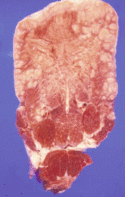Difference between revisions of "Actinobacillosis - Cattle"
Jump to navigation
Jump to search
| Line 9: | Line 9: | ||
==Description== | ==Description== | ||
| − | An infectious disease caused by the gram-negative coccobacilli[[Actinobacillus lignieresii]]. Characterised by inflammation of the soft tissues of the head especially the tongue and pharangeal lymph nodes of cattle and sheep. | + | An infectious disease caused by the gram-negative coccobacilli[[Actinobacillus lignieresii]]. Characterised by inflammation of the soft tissues of the head especially the tongue and pharangeal lymph nodes of cattle and sheep. The Causal agent is widespread in the environment and gets into the [[Oral Cavity - Tongue - Anatomy & Physiology|tongue]] via small abrasions.It can be a progressive disease - low virulence but high persistence so animal may stop eating and eventually die if they are not treated. |
| − | |||
| + | ==Signalment== | ||
| + | Occurs in cattle and sheep of all ages but particularly seen in young beef breeds particularly sucklers on poor forage. | ||
| − | + | ==Diagnosis== | |
| + | A diagnosis can be made on history and clinical signs. | ||
====Clinical==== | ====Clinical==== | ||
| − | + | ||
| − | *Starts like [[Picornaviridae#Foot and Mouth Disease Virus|foot and mouth disease]] - dull, salivating (if only one animal is unlikely to foot and mouth). - nearly always sporadic. | + | *Starts like [[Picornaviridae#Foot and Mouth Disease Virus|foot and mouth disease]] - dull, salivating (if only one animal is unlikely to foot and mouth). - nearly always sporadic. The tongue feels like a big lump of wood especially the dorsal part of posterior 2/3rds. |
| − | + | This is often found in conjunction with small areas of ulceration on the side of [[Oral Cavity - Tongue - Anatomy & Physiology|tongue]]. | |
| − | |||
====Pathogenesis==== | ====Pathogenesis==== | ||
| Line 26: | Line 27: | ||
*Very similar to [[Mandibular Osteomyelitis|Mandibular Osteomyelitis]] ("lumpy jaw"). | *Very similar to [[Mandibular Osteomyelitis|Mandibular Osteomyelitis]] ("lumpy jaw"). | ||
| − | + | ||
| − | |||
| − | |||
====Pathology==== | ====Pathology==== | ||
Revision as of 12:24, 27 July 2010
| This article is still under construction. |
| Also known as: | Wooden tongue |
Description
An infectious disease caused by the gram-negative coccobacilliActinobacillus lignieresii. Characterised by inflammation of the soft tissues of the head especially the tongue and pharangeal lymph nodes of cattle and sheep. The Causal agent is widespread in the environment and gets into the tongue via small abrasions.It can be a progressive disease - low virulence but high persistence so animal may stop eating and eventually die if they are not treated.
Signalment
Occurs in cattle and sheep of all ages but particularly seen in young beef breeds particularly sucklers on poor forage.
Diagnosis
A diagnosis can be made on history and clinical signs.
Clinical
- Starts like foot and mouth disease - dull, salivating (if only one animal is unlikely to foot and mouth). - nearly always sporadic. The tongue feels like a big lump of wood especially the dorsal part of posterior 2/3rds.
This is often found in conjunction with small areas of ulceration on the side of tongue.
Pathogenesis
- Very similar to Mandibular Osteomyelitis ("lumpy jaw").
Pathology
- If cut into tongue, substance of tongue changed to fibrous stroma with raised red nodules. (2-3mm across).
- This lesion is a pyogenic granuloma with central sulphur body.
- Can spread from tongue to other tissues e.g. retropharyngeal lymph nodes and palate.
- This type of lesion is caused by the host response to the pathogen, rather than directly a pathogen effect.
Other sites
- Occasionally can see generalised infections but more commonly spreads to local lymph nodes of alimentary tract.
- Organism can be inhaled causing actinobacillus pneumonia.
- Can affect rumen wall.
- In skin forms a neoplastic like mass in dermis.
- Small granulomatous lesions containing 'sulfa granules' of large numbers of gram-negative rods

